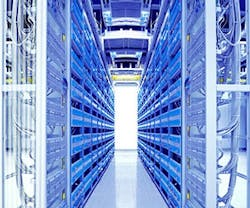Data Center Design: Cooling and Airflow Tactics
What do you get when you mix hot aisle containment, chilled water systems, and a water-side economizer? Ten years ago, this sounded like a mad scientist’s concoction, but today the combined strategies are driving data center efficiency.
Intel’s Jones Farm in Hillsboro, OR, is a two-story, 70,000-square-foot data center that has been in operation since 2006. As technology shrunk yet grew in complexity, Intel’s computing requirements have grown 700% in six years.
“We became the early adopters of several techniques,” says Paul Vaccaro, data center engineer for Intel. “People thought we were crazy.”
Implementing the philosophy “if you can’t measure it, you can’t manage it,” Intel began designing the Jones Farm campus in 2004. Outside, there are two chilled water systems. The low-temperature tank is used for the office and humidification control for the data centers, while the high-temperature one handles the bulk of the cooling. The former provides 350 tons of it, while the latter can deliver up to 6,000 tons at full build-out. A water-side economizer drives efficiency further.
“At 45 degrees F. outside, we have full free cooling,” explains David Seger, PE and LEED AP for CH2MHill/IDC Architects, the firm that helped design, construct, and operate the facility. “From there, we implemented a strategy to cascade energy efficiency.”
The second part of the strategy involves airflow management on the inside. Hot air off the servers is drawn from the return plenum down through recirculation air handlers and into a supply plenum below, where it goes through filter coils.
There, it cools electrical gear below the data center, goes up through floor slots, and is pulled back into the servers, Seger explains.
If it sounds complicated, that’s because it is. The system moves 500,000 cubic feet of air per minute.
“It’s one big donut of movement,” says Seger. “It’s all about getting the air through the circle as efficiently as possible.”
All of the fans, handlers, and IT equipment are tracked, allowing operators to continuously monitor energy-slashing opportunities.
“We only supply chilled water based on IT load. That came from the ASHRAE concept of zoning by temperature. It saved us $130,000 annually off our utility bill,” Vaccaro says. “At another point we decided to change filters ahead of manufacturer specifications based on the particle count we saw. That saved $10,000 per year.”
Vaccaro calls Jones Farm the father of data centers at Intel and argues that it could be for the industry as well. These strategies are becoming commonplace in new designs.
“The opportunity is measuring and managing,” he says. “Focus on your facilities department and IT systems together.”
